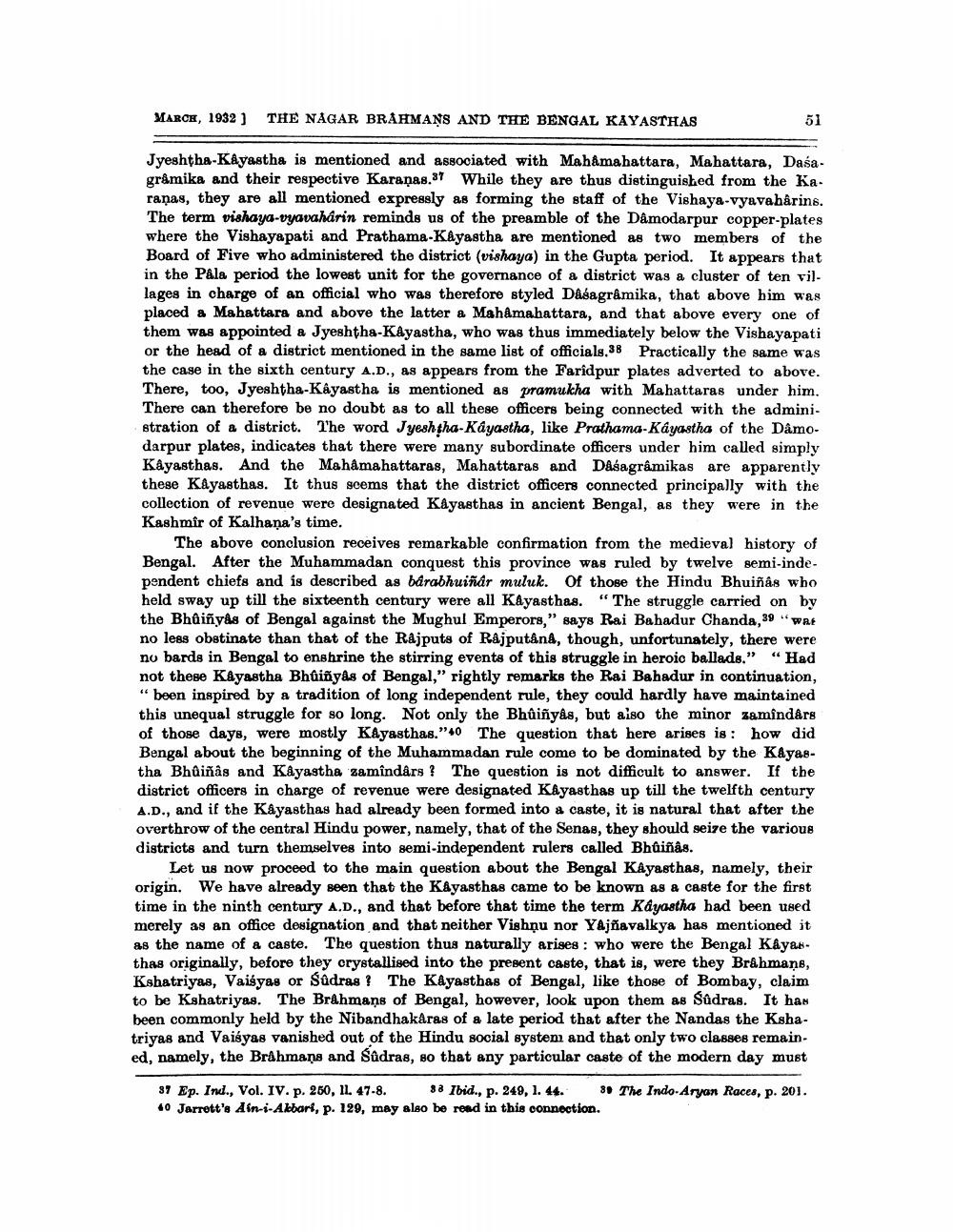________________
MAROK, 1932) THE NAGAR BRAĦMANS AND THE BENGAL KAYASTHAS
51
Jyeshtha-Kayastha is mentioned and associated with Mahamahattara, Mahattara, Dasagråmika and their respective Karanas.37 While they are thus distinguished from the Ka. raņas, they are all mentioned expressly as forming the staff of the Vishaya-vyavahårins. The term vishaya-vyavahárin reminds us of the preamble of the Damodarpur copper-plates where the Vishayapati and Prathama-Kayastha are mentioned as two members of the Board of Five who administered the district (vishaya) in the Gupta period. It appears that in the Pala period the lowest unit for the governance of a district was a cluster of ten villages in charge of an official who was therefore styled Dasagrâmika, that above him was placed a Mahattara and above the latter a Mahamahattara, and that above every one of them was appointed a Jyeshtha-Kayastha, who was thus immediately below the Vishayapati or the head of a district mentioned in the same list of officials.38 Practically the same was the case in the sixth century A.D., as appears from the Faridpur plates adverted to above. There, too, Jyeshtha-Kayastha is mentioned as pramukha with Mahattaras under him. There can therefore be no doubt as to all these officers being connected with the administration of a district. The word Jyeshtha-Kayastha, like Prathama-Kayastha of the Damodarpur plates, indicates that there were many subordinate officers under him called simply Kayasthas. And the Mahamahattaras, Mahattaras and Dasagrâmikas are apparently these Kayasthas. It thus seems that the district officers connected principally with the collection of revenue were designated Kayasthas in ancient Bengal, as they were in the Kashmir of Kalhana's time.
The above conclusion receives remarkable confirmation from the medieval history of Bengal. After the Muhammadan conquest this province was ruled by twelve semi-independent chiefs and is described as bárabhuiñár muluk. Of those the Hindu Bhuiñâs who held sway up till the sixteenth century were all Kayasthas. “The struggle carried on by the Bhuiñyds of Bengal against the Mughul Emperors," says Rai Bahadur Chanda, 39 WAE no less obstinate than that of the Rajputs of Rajputând, though, unfortunately, there were no bards in Bengal to enshrine the stirring events of this struggle in heroic ballads." "Had not these Kayastha Bhúiñyas of Bengal," rightly remarks the Rai Bahadur in continuation, “boen inspired by a tradition of long independent rule, they could hardly have maintained this unequal struggle for so long. Not only the Bhûiñyås, but also the minor zamindars of those days, were mostly Kayasthas."40 The question that here arises is: how did Bengal about the beginning of the Muhammadan rule come to be dominated by the Kayastha Bhûiñas and Kayastha zamîndârs? The question is not difficult to answer. If the district officers in charge of revenue were designated Kayasthas up till the twelfth century A.D., and if the Kayasthas had already been formed into a caste, it is natural that after the overthrow of the central Hindu power, namely, that of the Senas, they should seize the various districts and turn themselves into semi-independent rulers called Bhùiñas.
Let us now proceed to the main question about the Bengal KAyasthas, namely, their origin. We have already seen that the Kayasthas came to be known as a caste for the first time in the ninth century A.D., and that before that time the term Kayastha had been used merely as an office designation and that neither Vishņu nor YAjñavalkya has mentioned it as the name of a caste. The question thus naturally arises: who were the Bengal Kayan. thas originally, before they crystallised into the present caste, that is, were they Brahmans, Kshatriyas, Vaisyas or Sudras? The Kayasthas of Bengal, like those of Bombay, claim to be Kshatriyas. The Brahmans of Bengal, however, look upon them as Sudras. It has been commonly held by the Nibandhakaras of a late period that after the Nandas the Kshatriyas and Vaisyas vanished out of the Hindu social systen and that only two classes remained, namely, the Brahmaņa and Sadras, so that any particular caste of the modern day must
37 Ep. Inul., Vol. IV. p. 250, 11 47-8. 88 Ibid., p. 249, 1. 44. 1 The Indo-Aryan Races, p. 201. 40 Jarrett's Ain-i-Akbari, p. 129, may also be read in this connection.




